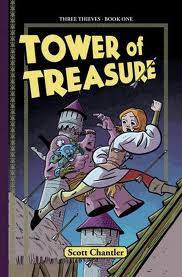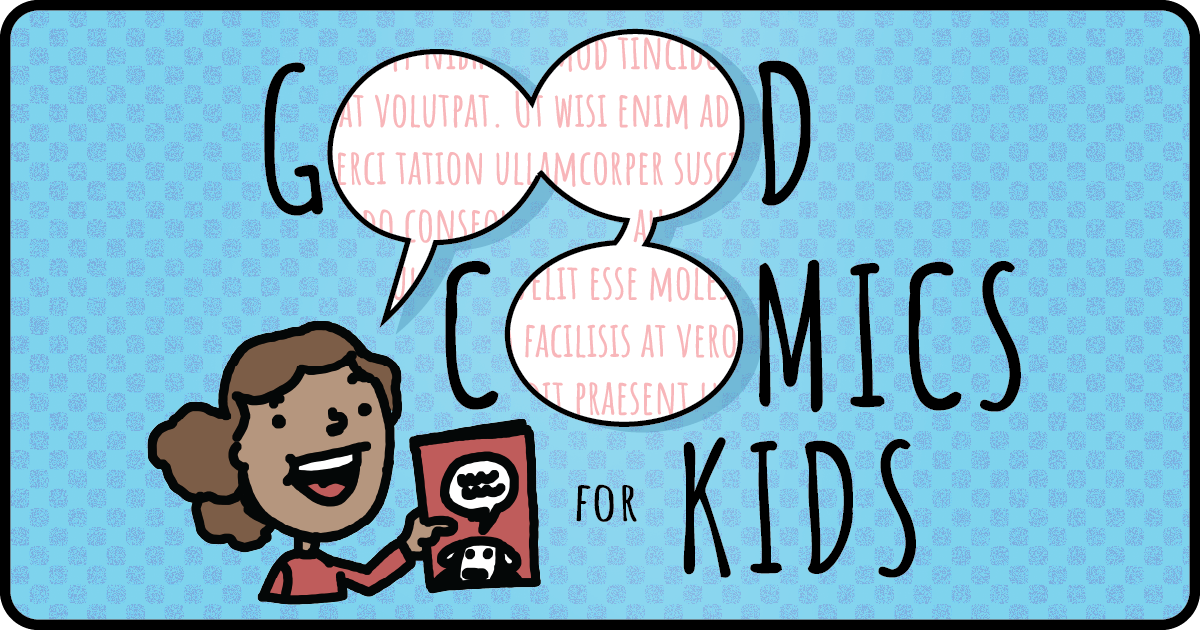
Interview: Scott Chantler on Tower of Treasure
 When I saw early pages of what would become Tower of Treasure, 3 years ago, I knew it would be the kind of book that would find an audience immediately. From the mind of Scott Chantler, the first book in the Three Thieves series combines a sure fire-genre—fantasy, a trio of strong main characters and clean, bright and appealing artwork. This series is sure to quickly gain fans, young and old.
When I saw early pages of what would become Tower of Treasure, 3 years ago, I knew it would be the kind of book that would find an audience immediately. From the mind of Scott Chantler, the first book in the Three Thieves series combines a sure fire-genre—fantasy, a trio of strong main characters and clean, bright and appealing artwork. This series is sure to quickly gain fans, young and old.
Chantler began his career at Oni Press collaborating with writer J. Torres on books like Scandalous and Days Like This. Northwest Passage was his first full length graphic novel solely written and illustrated by him. Scott Chantler has now turned his talents to kids with the release of his first graphic novel for ages 8-12 published by Kids Can Press. His books have been nominated for the Eisner, Harvey, Russ Manning, Joe Shuster, and Doug Wright Awards, and been recommended by the American Library Association and the Junior Library Guild. Quite the impressive list!
ADVERTISEMENT
ADVERTISEMENT
I had the opportunity to talk to Scott about some of the behind-the-scenes development of Tower of Treasure and his Three Thieves series.
Can you tell readers a bit about Tower of Treasure and Three Thieves in general?
Sure. It’s the story of Dessa Redd, a young circus acrobat who’s making her way across a fantasy world in search of her missing twin brother. She has a couple of goofy sidekicks, Topper and Fisk, who convince her to help them rob the Queen’s treasury. When that goes comically awry, they are pursued by The Queen’s Dragons, who are the Queen’s personal guard, and the greatest knights in the kingdom. So while our heroes search for Dessa’s brother, they are being searched for themselves, which provides lots of opportunity for chases, narrow escapes, and derring-do!
What kind of reader do you think would enjoy this series?
When I’m writing it, I’m very much trying to please the 10-year-old within myself. So I hope it will appeal to actual 10-year-olds, or anyone else with a 10-year-old inside them.
In writing this series, what decisions did you make in order to make Tower of Treasure different than all the fantasy books currently available to readers?
The whole idea of Three Thieves was to forego the seriousness and tedious world-building that makes a lot of contemporary fantasy so dreary. I consider the series something of a throwback to the days when “fantasy” meant a certain amount of whimsy, and rollicking high adventure. It’s not the kind of fantasy book with maps to pore over and invented politics and history for fans to argue about. It’s about characters, action, jokes, fun, and more action.
In addition–and this should become more clear as the series progresses–I’ve turned the traditional medieval-style fantasy setting on its ear by making the world overpopulated. Most fantasy stories are set in pastoral, pre-Industrial landscapes filled with forests, mountains, and other wild places. But Dessa’s world is more like Tolkien’s Middle-Earth if Saruman really had taken over: full of people and machines. There will never be a point in the series where they’re not in a town, city, castle, or some other populated place. Because wide open spaces don’t exist in Dessa’s world.
How important is humour in the story and what elements of humour did you consciously incorporate?
Humour is very important to the overall feel of the book, and will continue to be throughout the series. When you’ve got these sort of roguish, swashbuckling characters, snappy dialogue is really just part of the game. And part of pleasing the 10-year-old in me, like I mentioned before, is just letting the characters loose to joke and riff with each other. It helps get the reader on their side, and helps lighten what might otherwise seem to be overly dangerous and threatening situations.
 Tower of Treasure has a strong female main character- what made you decide on girl protagonist? What are the importance of Fisk and Topper to Dessa and to the story in general?
Tower of Treasure has a strong female main character- what made you decide on girl protagonist? What are the importance of Fisk and Topper to Dessa and to the story in general?
When I first began writing the pitch, the main character was a boy. But I just couldn’t get over how typical the whole thing seemed. I really wanted some hook, something to make this not just your traditional fantasy tale. And changing the gender of the lead character just seemed sort of natural. This type of physically heroic adventure is usually rather boy-centric, so making Dessa a girl gave her a certain kind of sass that became the character’s defining trait. And the decision proved to be quite practical: the publisher of the series, Kids Can Press, said that one of the things that really attracted them to it was the female protagonist.
As far as Fisk and Topper go, they are true sidekicks in that I don’t expect them to ever take over as leads in stories of their own. They’re largely there for comic relief, to be something for Dessa to react to, and also to help her in her quest. If figure as long as I’ve got an acrobat, a strongman, and a juggler, they’re going to have the skills to escape from just about any situation I can put them in. And three is a nice number, both dramatically and in terms of the traditions of the genre. Three characters just felt right.
In Tower of Treasure, there’s no traditional ‘pure evil’ villain. Is there one forthcoming that we haven’t been introduced to yet? Will readers see any monsters typically found in fantasy books?
I think it will become clear, as the series progresses, exactly who the bad guys are. The trend nowadays is to have your villains be somewhat sympathetic or relatable, but I actually have no problem with “pure evil,” especially when writing for children. Most of the characters we meet are going to be somewhere on the spectrum between good and bad, but in Dessa’s world, just as in ours, some people are just plain greedy, mean, power-hungry, and horrible, without much reason to be.
As for monsters, that’s going to be another difference between the world of Three Thieves and other fantasy worlds. With the exception of ettins and norkers (Fisk’s and Topper’s races, respectively) there will be no monsters in these books. As Dessa says at the start of Tower of Treasure, “there’s no such thing as dragons,” and she means it. Likewise, there is no magic. I figure fantasy fans are likely monster-ed and magic-ed out by now, anyway. The “magic” is Dessa’s world is what the rest of us will recognize as science. And the “monsters” are people.
There are many subplots set up in the first volume, especially regarding Dessa’s past and her quest to find her brother. Any hints on what’s in store for her in later volumes?
ADVERTISEMENT
ADVERTISEMENT
Oh, I could tell you so much! But I’m not going to. Suffice it to say that there’s definitely a lot more going on in Tower of Treasure than meets the eye.
Are there any kids graphic novels or comics that you’ve read lately that have really stood out for you?
I don’t get as much time to read as you might think, because I’m usually so busy making comics. That said, Kean Soo’s Jellaby was a big hit with my kids, and with me, too. I think it captures the feelings of childhood, both the positive and the negative, remarkably well. And, like everyone, I’m so happy with Thor: The Mighty Avenger by Roger Langridge and Chris Samnee. It’s a relief to actually be able to give a superhero comic to my kids.
Any advice to young comics creators?
For kids, I’d just say to draw, draw, draw and write, write, write. Look at the way that your favourite artists draw, and try to figure out why they’re doing it that way. Think about your favourite stories, and try to figure out why the writer told it that way and not some other way. And just practice, practice, practice. You can’t start too young.
For teenagers or young adults who are seriously thinking about getting started on a possible career, I would tell them to always remember that comics is about storytelling, not picture-making. Drawing skills are essential, but learn what to draw, in terms of communicating a narrative, not just how to draw. Study Will Eisner. Study Scott McCloud. Study filmmaking theory. Storytelling is all about making choices, so learn to get inside the heads of great storytellers and figure out what guides their decisions about composition, angles, rhythm, timing, character performance, lighting, colour, drawing style. And to never forget that comics is an ART form, capable of expressing anything they might want to express, in whatever style they may want to express it. So don’t just ape what your favourite artist is doing…be yourself, and have something to say.
Haven’t read Tower of Treasure yet? Kids Can Press has a sneak peek of the first chapter available on their website as a downloadable PDF.
Filed under: Interviews, Uncategorized
About Scott Robins
Scott Robins is a librarian at the Toronto Public Library and the co-author of A Parent's Guide to the Best Kids' Comics. He is the children's programming director for the annual Toronto Comic Arts Festival. He has also served on the graphic novel selection committee for the Canadian Children's Book Centre's Best Books for Kids and Teens and is a jury member of the Joe Shuster Awards in the "Comics for Kids" category.
ADVERTISEMENT
ADVERTISEMENT
SLJ Blog Network
One Star Review, Guess Who? (#202)
This Q&A is Going Exactly As Planned: A Talk with Tao Nyeu About Her Latest Book
Parsing Religion in Public Schools
Take Five: LGBTQIA+ Middle Grade Novels
ADVERTISEMENT








This looks FANTASTIC! I love the pdf preview! Thanks for posting.